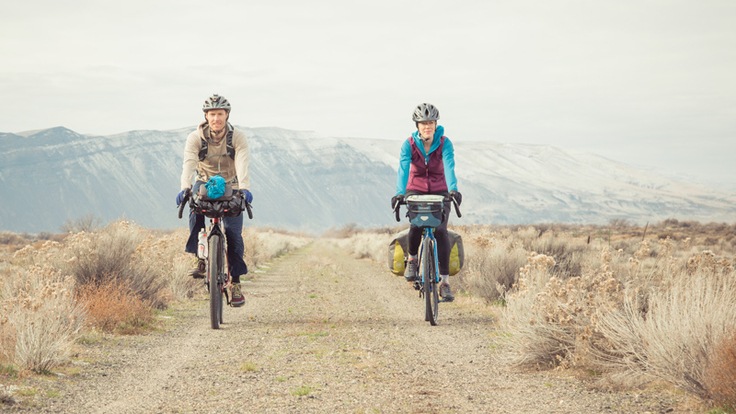Bikepacking in its purest form explores off-pavement roads and trails, which makes a mountain bike an ideal choice for many riders. But really, there's no one bike right for bikepacking; bikepackers use everything from touring bikes to full-suspension rigs on their explorations. Finding the best bike for you often requires balancing your priorities and accepting certain tradeoffs.
How to Choose a Bike for Bikepacking
- Consider terrain: Where you ride is perhaps the single most important factor in determining the appropriate bike.
- Choose suspension or rigid: Suspension smooths out rough trails, but it also adds weight and complexity to your bike. Your choices include fully rigid (no suspension), hardtail (front suspension) or full suspension.
- Think about gearing: In general, you want more easy gears than hard gears so you can climb hills with your loaded bike.
- Select a wheel and tire size: Wheel and tire size can affect efficiency, comfort and ride performance on the trail. In general, larger wheels and tires provide a faster, smoother ride, but they are also heavier.
- Consider frame material: Different materials have different feels. Many bikepackers choose chromoly steel or carbon for the smooth ride quality, but aluminum is also an option. If you're willing to splurge, titanium is a possibility.
Keep in mind that getting into bikepacking does not mean you have to buy a bunch of new expensive gear. It's very possible that the bike you have at home can take you where you want to go. As you read this article, assess the gear you already own and decide whether or not it will work for the types of adventures you want to take.
Terrain
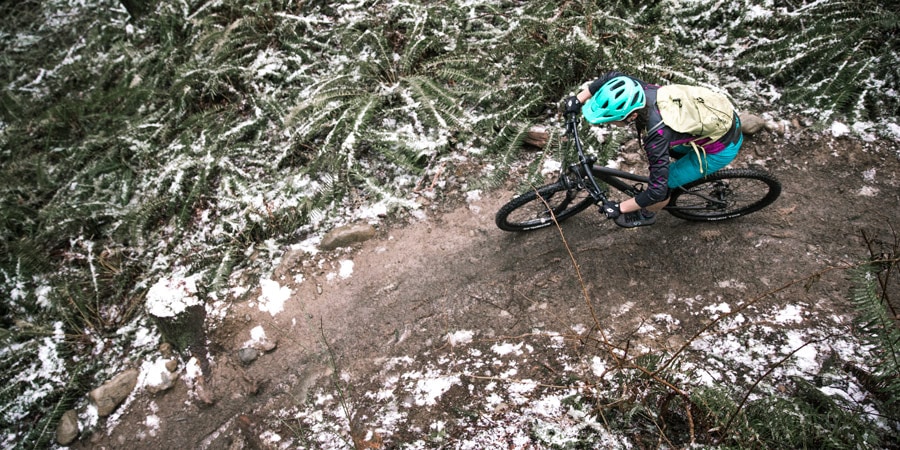
Naturally, a bike that's built for pavement is not the best choice for rugged singletrack trails. When choosing a bike for bikepacking, it's very helpful to think about the type of terrain you'd like to ride and let that define the kind of bike you need.
Common bikepacking terrain types and tips on bike selection
- Mixed surfaces (pavement, dirt roads): Touring bikes, cyclocross bikes, gravel bikes and rigid mountain bikes are all options for riding on mixed surfaces. If you'll be strictly on pavement, a touring bike can work, but once you hit dirt roads, a cyclocross bike, gravel bike or rigid mountain bike will feel more secure. You'll appreciate the cushier ride and improved traction that knobby tires bring. Gravel bikes handle loose, chunky gravel and fast descents with more stability than touring bikes. A fully rigid mountain bike is heavier and slower, but it could be a good choice if you'll be spending the majority of your time on dirt roads.
- Gravel roads, forest roads and doubletrack: Gravel bikes, rigid mountain bikes and hardtail mountain bikes are good options. A rigid or hardtail mountain bike will be heavier than a gravel bike, but it provides better comfort and stability on fast, loose or rocky descents.
- Singletrack: Rigid mountain bikes and hardtail mountain bikes are popular options for bikepacking tours that take you on occasional singletrack. A mountain bike with front suspension will smooth out your ride and make it easier to navigate up and over roots and rocks. If you'll be primarily on technical singletrack, a full-suspension mountain bike a good choice. A fat-tire bike is another option. The massive tires will help smooth out the ride without adding the complexity of suspension.
Suspension
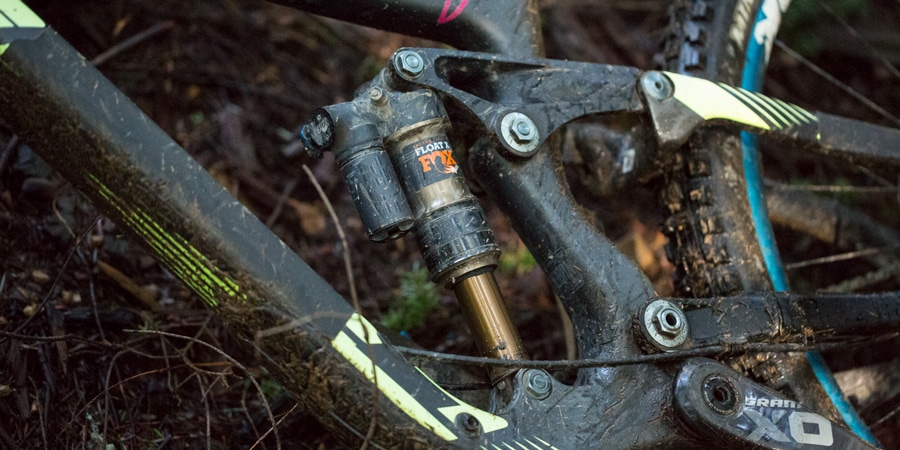
Suspension is great for smoothing out rough trails, but it also adds weight and design complexity to your bike. For this reason, most bikepackers try to match the type and amount of suspension to the terrain they'll be riding. Learn more about the differences between hardtail vs. full suspension.
Here are some suspension options for bikepacking:
- Fully rigid (no suspension): Without any suspension, rigid bikes have less components that require maintenance and are often lighter weight than hardtail and full-suspension bikes. But, they don't handle rough, technical terrain as well as bikes with suspension. Many bikepackers find rigid bikes to be the right choice for trips on mixed surfaces, such as pavement, dirt roads and smooth trails.
- Hardtail (front suspension fork): The addition of a suspension fork will help you navigate trails with some roots and rocks, and will make riding gravel roads at high speeds more pleasant. As with a fully rigid bike, they are fairly simple and light, and without a rear shock there is plenty of room for hauling gear in a frame pack.
- Full suspension: These bikes have front and rear shocks to absorb the impacts of technical terrain. If you'll be frequenting technical single track, a full-suspension ride might be for you. Be aware that the rear shock on most full-suspension bikes will reduce the space available for a frame bag for hauling gear.
Gearing
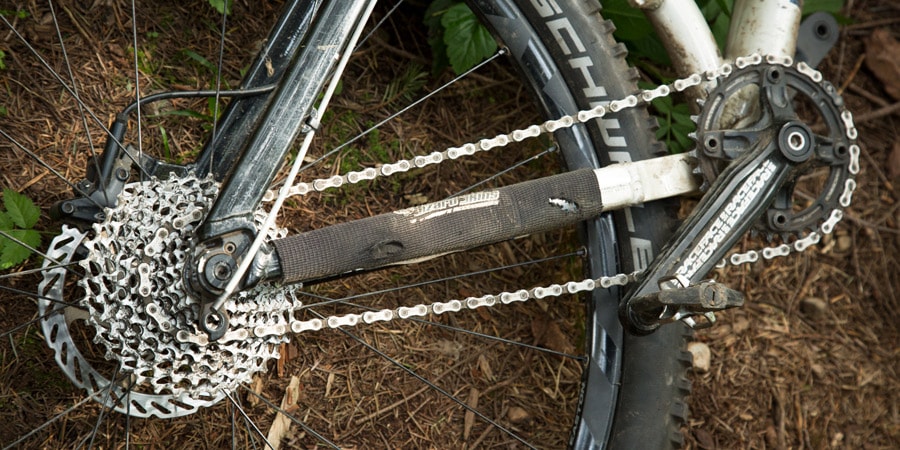
Some people like to geek out on gearing in a quest to find just the right setup to meet their needs. If this isn't you, you can keep it simple by riding a bike with the gears that come on it; a bike designed with bikepacking in mind will almost certainly have the appropriate gearing to get you where you want to go, as will most mountain bikes and gravel bikes.
If you want to delve a little deeper, there's a whole world of gearing possibilities out there for you. From internal geared hubs to the newest 12-speed drivetrain, the options are vast. When you're planning your bikepacking gearing, know that in general it's best to err on the side of having more easy gears than hard gears. For most bikepackers, this means having a couple of gears that are easier than anything you'd normally use. These easy gears will come in handy when you're riding your loaded bike up steep hills and over uneven terrain.
Many bikepackers choose to ride a 1x setup, meaning there is one chainring up front that's paired with a wide-range rear cassette. This setup eliminates the need for a front derailleur, creating a simple system that requires less maintenance and is also a tad lighter.
Possible gearing for bikepacking based on terrain:
(note: specific terrain features, fitness level and loaded bike weight largely influence how well certain gearing will work for you)
- Mixed surfaces (pavement, dirt roads): A 2x crankset with an 11 - 32 cassette or a 1x crankset with a 36- or 38-tooth chainring and an 10 - 42 cassette (choose the smaller chainring for easier gearing).
- Gravel roads, forest roads and doubletrack: 1x crankset with a 32- or 34-tooth chainring and an 10 - 42 rear cassette or an 11 - 46 cassette (choose the smaller chainring and larger cassette for easier gearing).
- Single track: 1x crankset with 28-tooth chainring and an 10 - 42 or 10 - 50 cassette (choose the 10 - 50 cassette for easier gearing).
Learn more about gearing.
Wheel and Tire Size
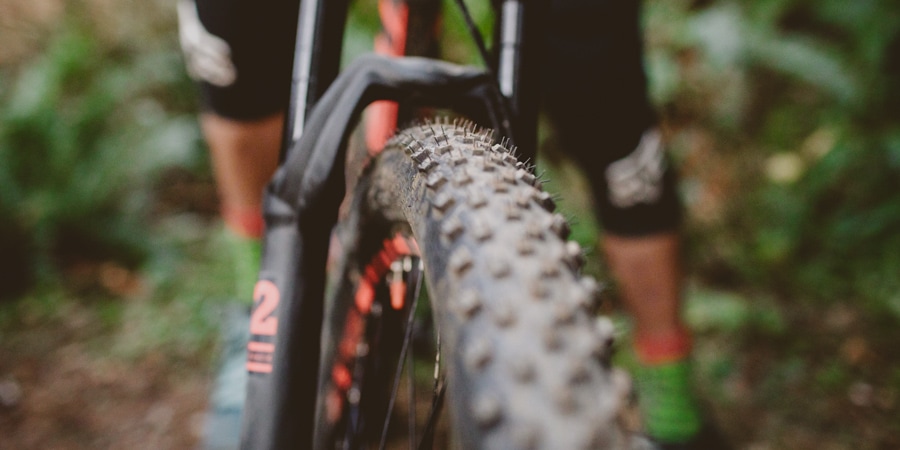
Wheel and tire size can affect how your bike handles the terrain you're riding on.
Wheel size: Most touring bikes, cyclocross bikes and gravel bikes come with the standard road wheel size, which is 700c. Some bike makers have recently gone to building bikes with "road plus" 650b wheels. These smaller wheels allow you to use fatter tires for a more comfortable ride, which can be nice when you're not on pavement. If you're riding a mountain bike, you have a couple choices: 27.5 in. and 29 in. (29er) wheels. Many mountain bikers insist that 29er wheels are best for long-distance trips because of their rolling efficiency, while others prefer 27.5 in. wheels for their responsiveness and nimbleness. There are pros and cons to each size and a lot of it comes down to personal preference. Learn more about wheel size in our article, 27.5" vs. 29er: Which Mountain Bike is Right for Me?
Tire size: Many bikepackers choose to put wider tires on their bike because, in general, wider tires provide extra comfort. But, keep in mind that wider tires do add weight and can feel slower than narrower ones. Also, before putting wider tires on your bike, you may need to do some research to make sure your bike has enough clearance to fit the tires without rubbing the frame.
Some mountain bikes can fit plus-size tires (those that range from about 2.5 to 3 inches wide). These can be particularly helpful on terrain you may run into while bikepacking, such as sandy, muddy or extremely rocky roads and trails. Huge fat-tire bike tires that measure 3.7 to 5+ inches give fat-tire bikes excellent traction in sand or snow, and the tires alone can smooth out a singletrack trail so well that you may not need front or rear suspension. Learn more about tire sizes in our article, How to Choose Bike Tires.
Tubeless tires: While thinking about wheel and tire size, you may also consider whether or not tubeless tires are right for you. Tubeless tires are lighter and often less prone to flats, but they are pricier and require a bit more work to install. Many bikepackers choose them for the weight savings and puncture resistance. You can learn more in our article about tubeless tires.
Frame Material
The material(s) used to make your bike can play a big part in determining how the bike feels while riding. Typically, bikepackers look to minimize weight while maintaining strength and ride quality.
Here are some common bike frame materials and what you can expect from them:
- Chromoly steel: Chromoly steel bikes are strong and they offer a smooth ride because the material itself absorbs some riding vibrations. Bikepackers often choose steel for its durability, especially when traveling long and far in remote locations. Steel is unlikely to break, but if it does, the damage can sometimes be repaired with welding.
- Carbon fiber: Carbon frames are very light, making them appealing to bikepackers looking to reduce their load. And, carbon can be constructed in a way to provide a nice smooth ride. However, some bikepackers shy away from carbon fiber over concerns that if it were to be badly damaged in a crash, it could be unrepairable.
- Aluminum: Aluminum frames are light and affordable, but they also tend to be really stiff, which means they can create a jarring, uncomfortable ride. Pairing an aluminum frame with a carbon fork or a suspension fork can help smooth things out.
- Titanium: Only the highest-end bikes are made with titanium. Titanium frames are light and very strong, and they offer an excellent ride quality, making them an ideal choice for bikepacking. But, titanium is so expensive that many bikepackers look to other options.
Learn more about bike frame materials.
